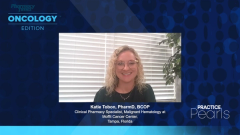
BTK Inhibitor Selection for CLL Therapy
Katie Tobon, PharmD, BCOP, and Javier Pinilla-Ibarz, MD, PhD, discuss factors to consider when selecting a BTK inhibitor for CLL therapy, including cytogenetic abnormalities as well as patient- and treatment-related factors.
Episodes in this series

Javier Pinilla-Ibarz, MD, PhD: In terms of selecting a BTK [Bruton tyrosine kinase] inhibitor for CLL [chronic lymphocytic leukemia] therapy, Katie, what do you think about cytogenetic abnormalities, patients, and other factors that can weigh when we start to select BTK inhibitors?
Katie Tobon, PharmD, BCOP: It’s a great question. Shared decision-making is our approach when it comes to BTK inhibitor therapy at our institution [Moffitt Cancer Center]. Data have shown a prolonged progression-free survival, particularly with the ability to overcome adverse prognostic factors, such as IGHV. That typically would give us shorter progression-free survival. All cytogenetic abnormalities are eligible, but it’s important to keep in mind that our 17p or TP53 patients have the shorter progression-free survival. For patient-related factors, there are a lot of things that we have to think about. We have to consider the patient’s age and what comorbid conditions they may have, especially cardiac history. Cardiac history is a big thing to keep in mind when we’re talking about BTK inhibitors, as well as the first and second generation. This includes arrhythmias, hypertension, a history of bleeding, and any other concomitant medications these patients are on. There are a lot of drug interactions that we’ll talk about shortly. We also have to consider how frail the patient is as well as the overall cost. Typically, if we have an older patient or a patient with multiple comorbid conditions that may be exacerbated, we’d prefer the second-generation BTK inhibitors. In terms of treatment-related factors, it’s a shared decision-making approach at our institution. Dr Pinilla-Ibarz, what other treatment factors do you consider with these discussions with your patients besides what I’ve discussed?
Javier Pinilla-Ibarz, MD, PhD: You discussed very important points. I want to emphasize the issue of cytogenetic or genomic factors. All these generic factors predict times to reach first therapy. When the therapy comes, obviously BTK is 1 of the important aspects and therapeutic strategies that we discuss with our patient. It depends on the comorbidities. We may rely more on a second- vs third-generation BTK inhibitor. At the same time, it’s important to consider patient preference in the terms do they want to go to fixed-duration therapy in combination with BTK, can they come to an academic institution despite the distance? In our state, people are old and may not be able to get on the road.
I want to emphasize that the issue with 17p. Obviously, with 17p or TP53 mutation in the front line, we do not recommend [chemoimmunotherapy]. My opinions will be almost contraindicated to use chemoimmunotherapy. For sure, BTKs are a very important aspect of how we’re dramatically improving the outcomes of patients with these genomic abnormalities. At the same time, there’s no doubt that the fixed duration can be used. But we already have data showing that as soon as we stop therapy, those patients’ tend to relapse shortly. It’s unclear how they can be re-treated.
In general, we prefer to reuse BTK inhibitors until this disease progression. In fact, we have good data coming, and we’ll discuss that later. For example, in the Alliance for Clinical Trials in Oncology trial that was updated, we saw that after almost 4 years of follow-up, the 17p is similar to non-17p. This trial is really encouraging and reinforces the idea that BTK inhibitors are an excellent choice for patients with these “high risk” cytogenetic abnormalities. In the past, with chemoimmunotherapy, with the new targeted therapies, it may not be as high. It’s completely different in the second and third line. The outcomes for those patients with targeted therapy may not be as good because we don’t have those kinds of therapies, but it’s an important factor to consider.
Transcript Edited for Clarity
Newsletter
Stay informed on drug updates, treatment guidelines, and pharmacy practice trends—subscribe to Pharmacy Times for weekly clinical insights.
















































































































































































































